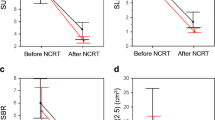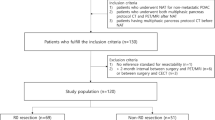Abstract
Purpose
Perineural invasion (PNI) has been recognized as an important prognosis factor in patients with colorectal cancer (CRC). The purpose of this retrospective study was to investigate the value of 18F-FDG PET/CT-based radiomics integrating clinical information, PET/CT features, and metabolic parameters for preoperatively predicting PNI and outcome in non-metastatic CRC and establish an easy-to-use nomogram.
Methods
A total of 131 patients with non-metastatic CRC who undergo PET/CT scan were retrospectively enrolled. Univariate analysis was used to compare the differences between PNI-present and PNI-absent groups. Multivariate logistic regression was performed to select the independent predictors for PNI status. Akaike information criterion (AIC) was used to select the best prediction models for PNI status. CT radiomics signatures (RSs) and PET-RSs were selected by maximum relevance minimum redundancy (mRMR) and the least absolute shrinkage and selection operator algorithm (LASSO) regression and radiomics scores (Rad-scores) were calculated for each patient. The prediction models with or without Rad-score were established. According to the nomogram, nomogram scores (Nomo-scores) were calculated for each patient. The performance of different models was assessed with the area under the curve (AUC), specificity, and sensitivity. The clinical usefulness was assessed by decision curve (DCA). Multivariate Cox regression was used to selected independent predictors of progression-free survival (PFS).
Results
Among all the clinical information, PET/CT features, and metabolic parameters, CEA, lymph node metastatic on PET/CT (N stage), and total lesion glycolysis (TLG) were independent predictors for PNI (p < 0.05). Six CT-RSs and 12 PET-RSs were selected as the most valuable factors to predict PNI. The Rad-score calculated with these RSs was significantly different between PNI-present and PNI-absent groups (p < 0.001). The AUC of the constructed model was 0.90 (95%CI: 0.83–0.97) in the training cohort and 0.80 (95%CI: 0.65–0.95) in the test cohort. The nomogram’s predicting sensitivity was 0.84 and the specificity was 0.83 in the training cohort. The clinical model’s predicting sensitivity and specificity were 0.66 and 0.85 in the training cohort, respectively. Besides, DCA showed that patients with non-metastatic CRC could get more benefit with our model. The results also indicated that N stage, PNI status, and the Nomo-score were independent predictors of PFS in patients with non-metastatic CRC.
Conclusion
The nomogram, integrating clinical data, PET/CT features, metabolic parameters, and radiomics, performs well in predicting PNI status and is associated with the outcome in patients with non-metastatic CRC.
Graphical abstract







Similar content being viewed by others
Data availability
The datasets generated and analyzed during the current study are not publicly available due to patient privacy concerns, but they are available from the corresponding author upon reasonable request.
Abbreviations
- FDG:
-
Fluorodeoxyglucose
- PET/CT:
-
Positron emission tomography/computed tomography
- PNI:
-
Perineural invasion
- CRC:
-
Colorectal cancer
- AIC:
-
Akaike information criterion
- RSs:
-
Radiomics signatures
- Rad-score:
-
Radiomics score
- Nomo-score:
-
Nomogram score
- AUC:
-
Area under curve
- DCA:
-
Decision curve analysis
- PFS:
-
Progression-free survival
- CEA:
-
Carcinoembryonic antigen
- TLG:
-
Total lesion glycolysis
References
Sung H, Ferlay J, Siegel RL, Laversanne M, Soerjomataram I, Jemal A, et al. Global Cancer Statistics 2020: GLOBOCAN Estimates of Incidence and Mortality Worldwide for 36 Cancers in 185 Countries. CA Cancer J Clin. 2021;71:209-49. doi:https://doi.org/10.3322/caac.21660.
Brouwer NPM, Bos A, Lemmens V, Tanis PJ, Hugen N, Nagtegaal ID, et al. An overview of 25 years of incidence, treatment and outcome of colorectal cancer patients. Int J Cancer. 2018;143:2758-66. doi:https://doi.org/10.1002/ijc.31785.
Watanabe T, Muro K, Ajioka Y, Hashiguchi Y, Ito Y, Saito Y, et al. Japanese Society for Cancer of the Colon and Rectum (JSCCR) guidelines 2016 for the treatment of colorectal cancer. Int J Clin Oncol. 2018;23:1-34. doi:https://doi.org/10.1007/s10147-017-1101-6.
Crippa S, Pergolini I, Javed AA, Honselmann KC, Weiss MJ, Di Salvo F, et al. Implications of Perineural Invasion on Disease Recurrence and Survival After Pancreatectomy for Pancreatic Head Ductal Adenocarcinoma. Ann Surg. 2020. doi:https://doi.org/10.1097/SLA.0000000000004464.
Delahunt B, Murray JD, Steigler A, Atkinson C, Christie D, Duchesne G, et al. Perineural invasion by prostate adenocarcinoma in needle biopsies predicts bone metastasis: Ten year data from the TROG 03.04 RADAR Trial. Histopathology. 2020;77:284-92. doi:https://doi.org/10.1111/his.14107.
Zhang Z, Zhou Y, Hu K, Wang D, Wang Z, Huang Y. Perineural invasion as a prognostic factor for intrahepatic cholangiocarcinoma after curative resection and a potential indication for postoperative chemotherapy: a retrospective cohort study. BMC Cancer. 2020;20:270. doi:https://doi.org/10.1186/s12885-020-06781-w.
Aurello P, Berardi G, Tierno SM, Rampioni Vinciguerra GL, Socciarelli F, Laracca GG, et al. Influence of perineural invasion in predicting overall survival and disease-free survival in patients With locally advanced gastric cancer. Am J Surg. 2017;213:748-53. doi:https://doi.org/10.1016/j.amjsurg.2016.05.022.
Totonchy MB, McNiff JM, Suozzi KC, Leffell DJ, Christensen SR. A Histopathologic Scoring System for Perineural Invasion Correlates With Adverse Outcomes in Patients With Cutaneous Squamous Cell Carcinoma. Dermatol Surg. 2021;47:445-51. doi:https://doi.org/10.1097/DSS.0000000000002923.
Wang H, Zheng Q, Lu Z, Wang L, Ding L, Xia L, et al. Role of the nervous system in cancers: a review. Cell Death Discov. 2021;7:76. doi:https://doi.org/10.1038/s41420-021-00450-y.
Chen SH, Zhang BY, Zhou B, Zhu CZ, Sun LQ, Feng YJ. Perineural invasion of cancer: a complex crosstalk between cells and molecules in the perineural niche. Am J Cancer Res. 2019;9:1-21.
van Wyk HC, Going J, Horgan P, McMillan DC. The role of perineural invasion in predicting survival in patients with primary operable colorectal cancer: A systematic review. Crit Rev Oncol Hematol. 2017;112:11-20. doi:https://doi.org/10.1016/j.critrevonc.2017.02.005.
Song JH, Yu M, Kang KM, Lee JH, Kim SH, Nam TK, et al. Significance of perineural and lymphovascular invasion in locally advanced rectal cancer treated by preoperative chemoradiotherapy and radical surgery: Can perineural invasion be an indication of adjuvant chemotherapy? Radiother Oncol. 2019;133:125-31. doi:https://doi.org/10.1016/j.radonc.2019.01.002.
Tu J, Yao Z, Wu W, Ju J, Xu Y, Liu Y. Perineural Invasion Is a Strong Prognostic Factor but Not a Predictive Factor of Response to Adjuvant Chemotherapy in Node-Negative Colon Cancer. Front Oncol. 2021;11:663154. doi:https://doi.org/10.3389/fonc.2021.663154.
Cienfuegos JA, Martinez P, Baixauli J, Beorlegui C, Rosenstone S, Sola JJ, et al. Perineural Invasion is a Major Prognostic and Predictive Factor of Response to Adjuvant Chemotherapy in Stage I-II Colon Cancer. Ann Surg Oncol. 2017;24:1077-84. doi:https://doi.org/10.1245/s10434-016-5561-0.
Stojkovic Lalosevic M, Milovanovic T, Micev M, Stojkovic M, Dragasevic S, Stulic M, et al. Perineural invasion as a prognostic factor in patients with stage I-III rectal cancer - 5-year follow up. World J Gastrointest Oncol. 2020;12:592-600. doi:https://doi.org/10.4251/wjgo.v12.i5.592.
Sun Q, Liu T, Liu P, Luo J, Zhang N, Lu K, et al. Perineural and lymphovascular invasion predicts for poor prognosis in locally advanced rectal cancer after neoadjuvant chemoradiotherapy and surgery. J Cancer. 2019;10:2243-9. doi:https://doi.org/10.7150/jca.31473.
Skancke M, Arnott SM, Amdur RL, Siegel RS, Obias VJ, Umapathi BA. Lymphovascular Invasion and Perineural Invasion Negatively Impact Overall Survival for Stage II Adenocarcinoma of the Colon. Dis Colon Rectum. 2019;62:181-8. doi:https://doi.org/10.1097/DCR.0000000000001258.
Nikberg M, Chabok A, Letocha H, Kindler C, Glimelius B, Smedh K. Lymphovascular and perineural invasion in stage II rectal cancer: a report from the Swedish colorectal cancer registry. Acta Oncol. 2016;55:1418-24. doi:https://doi.org/10.1080/0284186X.2016.1230274.
Al-Sukhni E, Attwood K, Gabriel EM, LeVea CM, Kanehira K, Nurkin SJ. Lymphovascular and perineural invasion are associated with poor prognostic features and outcomes in colorectal cancer: A retrospective cohort study. Int J Surg. 2017;37:42-9. doi:https://doi.org/10.1016/j.ijsu.2016.08.528.
Mirkin KA, Hollenbeak CS, Mohamed A, Jia Y, El-Deiry WS, Messaris E. Impact of perineural invasion on survival in node negative colon cancer. Cancer Biol Ther. 2017;18:740-5. doi:https://doi.org/10.1080/15384047.2017.1323602.
Alotaibi AM, Lee JL, Kim J, Lim SB, Yu CS, Kim TW, et al. Prognostic and Oncologic Significance of Perineural Invasion in Sporadic Colorectal Cancer. Ann Surg Oncol. 2017;24:1626-34. doi:https://doi.org/10.1245/s10434-016-5748-4.
Staal FCR, van der Reijd DJ, Taghavi M, Lambregts DMJ, Beets-Tan RGH, Maas M. Radiomics for the Prediction of Treatment Outcome and Survival in Patients With Colorectal Cancer: A Systematic Review. Clin Colorectal Cancer. 2021;20:52-71. doi:https://doi.org/10.1016/j.clcc.2020.11.001.
Yang L, Dong D, Fang M, Zhu Y, Zang Y, Liu Z, et al. Can CT-based radiomics signature predict KRAS/NRAS/BRAF mutations in colorectal cancer? Eur Radiol. 2018;28:2058-67. doi:https://doi.org/10.1007/s00330-017-5146-8.
Fan S, Cui X, Liu C, Li X, Zheng L, Song Q, et al. CT-Based Radiomics Signature: A Potential Biomarker for Predicting Postoperative Recurrence Risk in Stage II Colorectal Cancer. Front Oncol. 2021;11:644933. doi:https://doi.org/10.3389/fonc.2021.644933.
Li M, Li X, Guo Y, Miao Z, Liu X, Guo S, et al. Development and assessment of an individualized nomogram to predict colorectal cancer liver metastases. Quant Imaging Med Surg. 2020;10:397-414. doi:https://doi.org/10.21037/qims.2019.12.16.
Li Y, Eresen A, Shangguan J, Yang J, Benson AB, 3rd, Yaghmai V, et al. Preoperative prediction of perineural invasion and KRAS mutation in colon cancer using machine learning. J Cancer Res Clin Oncol. 2020;146:3165-74. doi:https://doi.org/10.1007/s00432-020-03354-z.
He J, Wang Q, Zhang Y, Wu H, Zhou Y, Zhao S. Preoperative prediction of regional lymph node metastasis of colorectal cancer based on (18)F-FDG PET/CT and machine learning. Ann Nucl Med. 2021;35:617-27. doi:https://doi.org/10.1007/s12149-021-01605-8.
Marchesi F, Piemonti L, Mantovani A, Allavena P. Molecular mechanisms of perineural invasion, a forgotten pathway of dissemination and metastasis. Cytokine Growth Factor Rev. 2010;21:77-82. doi:https://doi.org/10.1016/j.cytogfr.2009.11.001.
Liebig C, Ayala G, Wilks JA, Berger DH, Albo D. Perineural invasion in cancer: a review of the literature. Cancer. 2009;115:3379-91. doi:https://doi.org/10.1002/cncr.24396.
Zhang J, Zhao X, Zhao Y, Zhang J, Zhang Z, Wang J, et al. Value of pre-therapy (18)F-FDG PET/CT radiomics in predicting EGFR mutation status in patients with non-small cell lung cancer. Eur J Nucl Med Mol Imaging. 2020;47:1137-46. doi:https://doi.org/10.1007/s00259-019-04592-1.
Nie P, Yang G, Wang N, Yan L, Miao W, Duan Y, et al. Additional value of metabolic parameters to PET/CT-based radiomics nomogram in predicting lymphovascular invasion and outcome in lung adenocarcinoma. Eur J Nucl Med Mol Imaging. 2021;48:217-30. doi:https://doi.org/10.1007/s00259-020-04747-5.
Li Y, Zhang Y, Fang Q, Zhang X, Hou P, Wu H, et al. Radiomics analysis of [(18)F]FDG PET/CT for microvascular invasion and prognosis prediction in very-early- and early-stage hepatocellular carcinoma. Eur J Nucl Med Mol Imaging. 2021. doi:https://doi.org/10.1007/s00259-020-05119-9.
Kang J, Lee JH, Lee HS, Cho ES, Park EJ, Baik SH, et al. Radiomics Features of (18)F-Fluorodeoxyglucose Positron-Emission Tomography as a Novel Prognostic Signature in Colorectal Cancer. Cancers (Basel). 2021;13. doi:https://doi.org/10.3390/cancers13030392.
Khristenko E, Shrainer I, Setdikova G, Palkina O, Sinitsyn V, Lyadov V. Preoperative CT-based detection of extrapancreatic perineural invasion in pancreatic cancer. Sci Rep. 2021;11:1800. doi:https://doi.org/10.1038/s41598-021-81322-4.
Huang Y, He L, Dong D, Yang C, Liang C, Chen X, et al. Individualized prediction of perineural invasion in colorectal cancer: development and validation of a radiomics prediction model. Chin J Cancer Res. 2018;30:40-50. doi:https://doi.org/10.21147/j.issn.1000-9604.2018.01.05.
Chen J, Chen Y, Zheng D, Pang P, Zhang H, Zheng X, et al. Pretreatment MR-based radiomics nomogram as potential imaging biomarker for individualized assessment of perineural invasion status in rectal cancer. Abdom Radiol (NY). 2021;46:847-57. doi:https://doi.org/10.1007/s00261-020-02710-4.
Gillies RJ, Kinahan PE, Hricak H. Radiomics: Images Are More than Pictures, They Are Data. Radiology. 2016;278:563-77. doi:https://doi.org/10.1148/radiol.2015151169.
Park IJ, Choi GS, Lim KH, Kang BM, Jun SH. Serum carcinoembryonic antigen monitoring after curative resection for colorectal cancer: clinical significance of the preoperative level. Ann Surg Oncol. 2009;16:3087-93. doi:https://doi.org/10.1245/s10434-009-0625-z.
Godlewski J, Kmiec Z. Colorectal Cancer Invasion and Atrophy of the Enteric Nervous System: Potential Feedback and Impact on Cancer Progression. Int J Mol Sci. 2020;. doi:https://doi.org/10.3390/ijms21093391.
Kim SH, Song BI, Kim BW, Kim HW, Won KS, Bae SU, et al. Predictive Value of [(18)F]FDG PET/CT for Lymph Node Metastasis in Rectal Cancer. Sci Rep. 2019;9:4979. doi:https://doi.org/10.1038/s41598-019-41422-8.
Acknowledgements
Not applicable
Funding
None.
Author information
Authors and Affiliations
Corresponding authors
Ethics declarations
Conflict of interest
The authors declare that they have no conflicts of interest.
Additional information
Publisher's Note
Springer Nature remains neutral with regard to jurisdictional claims in published maps and institutional affiliations.
Rights and permissions
About this article
Cite this article
Ma, J., Guo, D., Miao, W. et al. The value of 18F-FDG PET/CT-based radiomics in predicting perineural invasion and outcome in non-metastatic colorectal cancer. Abdom Radiol 47, 1244–1254 (2022). https://doi.org/10.1007/s00261-022-03453-0
Received:
Revised:
Accepted:
Published:
Issue Date:
DOI: https://doi.org/10.1007/s00261-022-03453-0




